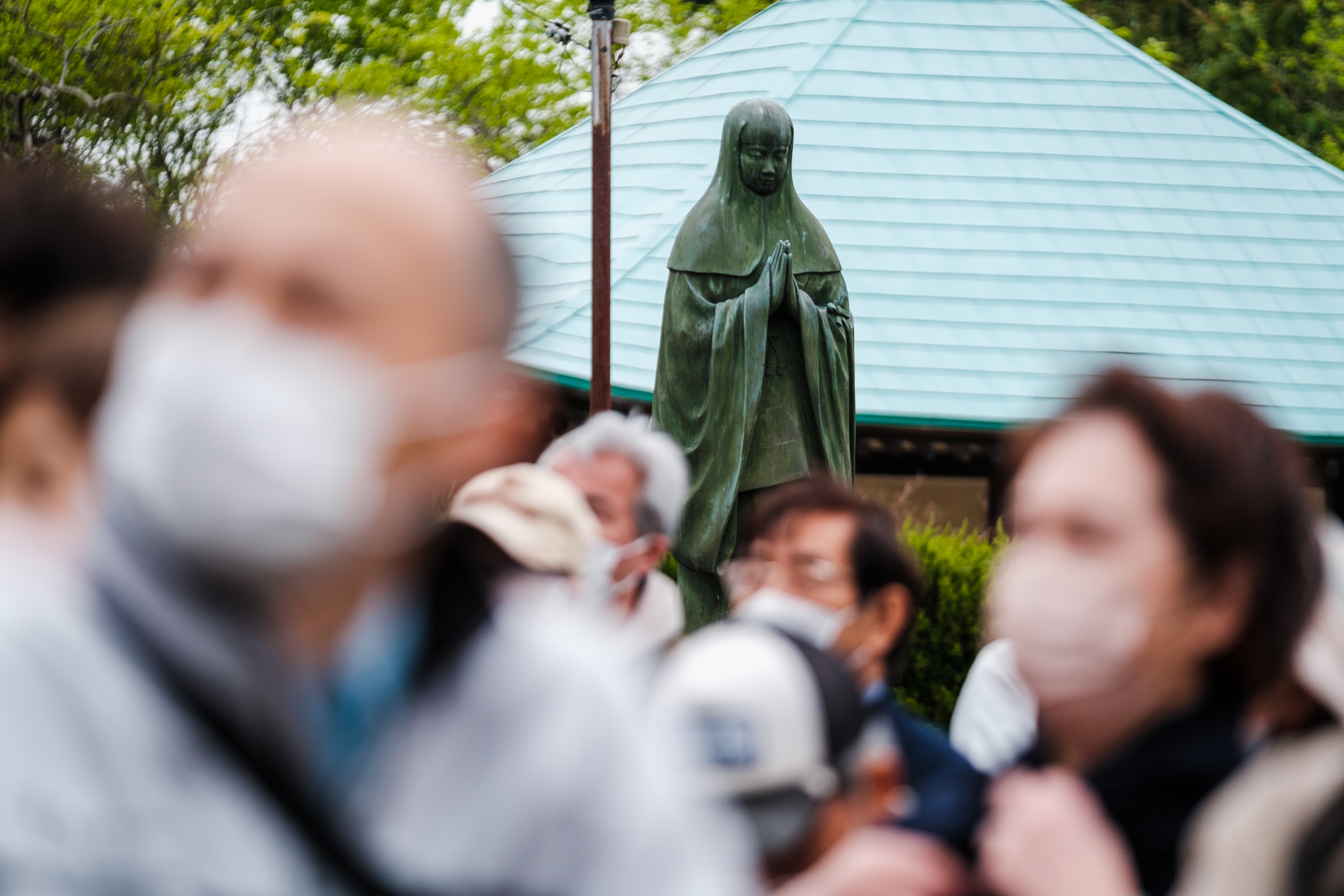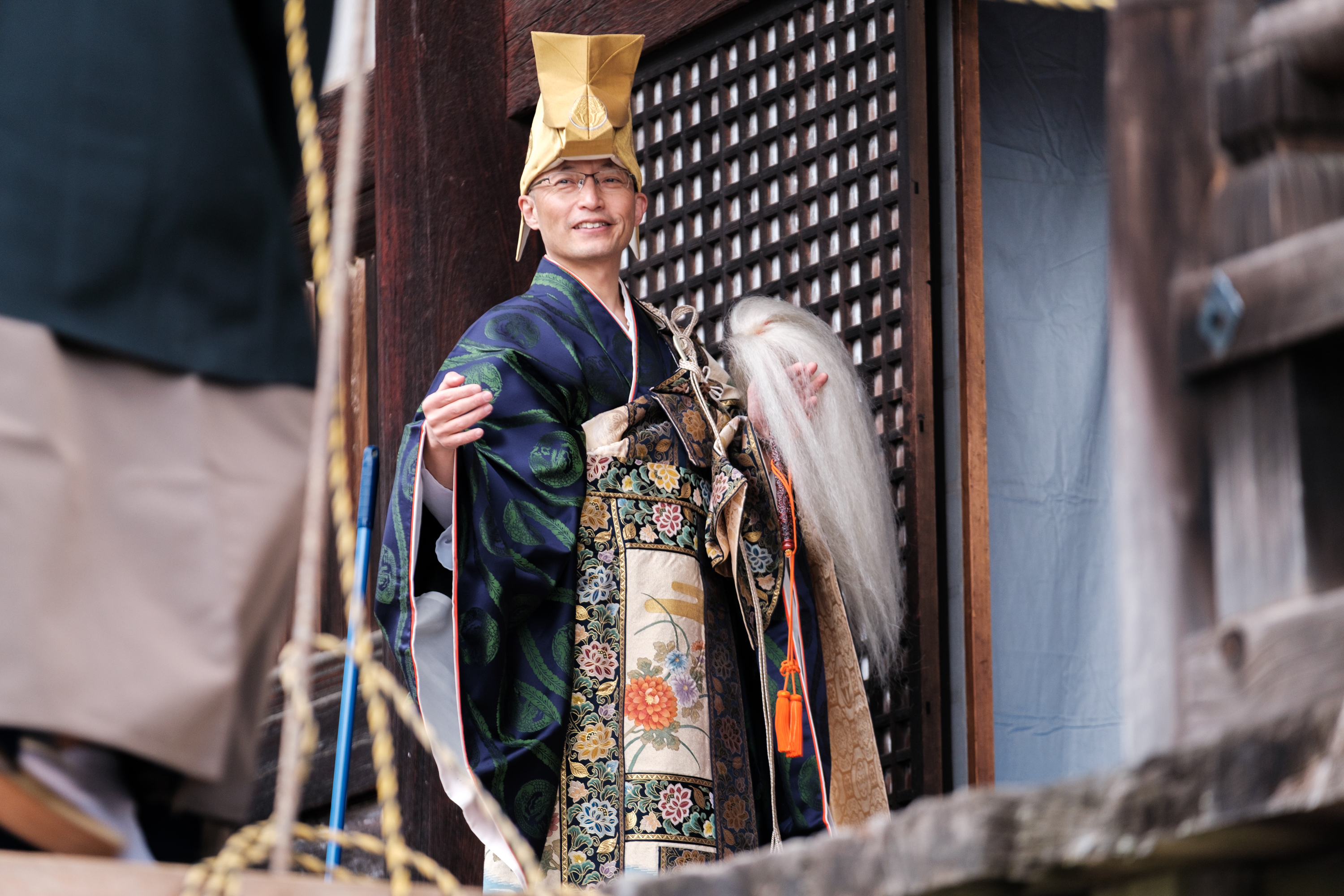The Buddhist Theatre of the Nerikuyo at Taimadera Temple
2024/03/11
Bodhisattvas are believed to walk among us, offering help in various guises to the unenlightened “foolish ones” (bonpu). But there are some encounters between the human and the divine that are acted out and theatrically staged in the Buddhist world across Asia. One example of this is that of Amida Buddha and a troupe of bodhisattvas emerging into the world to meet the souls of the dying and escort them to a paradise “Pure Land” which is enacted in the annual Nerikuyo Requiem Parade at Taimadera Temple in Nara, taking place on April 14th. The ceremonial performance depicts the salvation of one-time resident Princess Chujo (Chujohime) by twenty-five bodhisattvas who enter the world temporarily to greet her at death and escort her soul to the Buddhist paradise presided over by Amida Buddha. The two realms of the sacred and the profane are represented by the Pure Land Hall connected by a 110 metre long ramp to the Shabado Hall (“Hall of Defiled Land”).
The Buddhist tradition from which this performance draws its inspiration is Pure Land Buddhism, which was adopted in Japan in the seventh century and enjoyed a surge of popularity in the twelfth century. It remains widespread today. Its sutras taught that adherents could be reborn in a paradise in which Amida Buddha dwelled and where they could refine their mental states in order to ultimately exit the Samsaric wheel of life altogether. Literature and art portrayed the moment of departure in a guiding entourage of celestial beings, and rebirth from within lotus blossoms in the gardens of the Pure Land. One of these portrayals is the famous Taima Mandala painting, for which Taimadera is better known. This woven mandala (later copied in paint) was, according to legend, donated by Chujohime herself and depicted the paradise into which she was later believed to have been reborn.
But as appealing the comforting vision of death this offered was, the broader draw Pure Land Buddhism held for people was in the accessibility of its vision of salvation. It was non-exclusive and “easy”, requiring only faith in Amida. This may be why it produced dramatic public art like the Nerikuyo, which involved local members of the community both as performers and as audience. On March 21st, the Nerikuyo, performed by the Bodhisattva Confraternity of Gonen-in at Taimadera, will be officially designated and honoured as a National Important Intangible Folk Cultural Property. It was, and still is, a community-centred form of culture, based on a type of Buddhism especially embraced by ordinary people – even while it is anything but ordinary.
The sight of human bodhisattvas in brightly decorated brocade robes, gleaming masks and crowns, and white gloves, swaying down the ramp in procession (the “neri” of “Nerikuyo” refers to the swaying movement), followed by a palanquin transporting the princess, is a surreal and otherworldly one, but has something in common with Passion Plays or with the circumambulation of icons practiced in many religious cultures. Rehearsals of the performance are currently underway at Taimadera Gonen-in and on March 31st it will be announced who – of the local men who take on the theatrical roles – will play which bodhisattva. The most important roles are those of Kannon and Seishi, Amida Buddha’s attendants.
The Nerikuyo is thought to date back to the fifteenth century, though some of its existing masks are of an earlier period, and similar performances have and do take place at other temples too. It was also performed in China, and a variety of masks from the various monastic groups are preserved in temples and museums, including collections outside Japan. Masked drama has its own history inside Japan, having long been employed in Buddhist temple dance and drama festivities, though these masks were mostly secular and often comical ones. But they are most commonly found in Noh theatre, which in turn has links with Pure Land Buddhism, bringing us full circle back to Taimadera and its Pure Land paradise, particularly as Noh and the Nerikuyo flourished during the same period.

An outdoor statue of Princess Chujo (Chujohime), depicted in nun’s attire, rises above the crowds. Photo by Marco Lui

Kuzumoto Masataka, head priest of Taimadera’s Gonen’in cloister where Chujohime is believed to have once lived. Photo by Marco Lui
Dramatizations of Buddhist teachings are rather rare in Japan (unless one considers all ritual to be a form of dramatic theatre) so the Nerikuyo is a valuable form of dramatic Buddhist art, now officially recognised as such. Of note, too, is that the centrality of Chujohime emphasises the enlightenment of women in Buddhism, which was a possibility not accepted by all schools of Buddhism and that, while elaborate, the Nerikuyo is a non-elite, non-doctrinal work of art originally and still directed at the local community. And, like the mandala and its teachings, the Nerikuyo can offer comfort regarding the posthumous existences of ourselves or our loved ones. Chujohime’s life story is one of becoming a nun and taking refuge in Amida Buddha as a way out of her suffering, and the Taima Mandala was born of her prayer to see Amida Buddha in “living” form. Amida Buddha and Kannon bodhisattva responded by appearing to her in such a form, and they created the Taima Mandala. Today, the Nerikuyo, in transforming art into reality, gives us an opportunity too to be witness to seemingly living Buddhas, and, perhaps, to the presence in this world of the Buddhist one.
With thanks to Taimadera Gonen’in for information and guidance, and to Marco Lui for the photos, including the featured image
Taimadera Station, of the Kintetsu Minami-Osaka train line, is the easiest point of access for the Taima Temple. From there, it is a walk of 15-20 minutes on foot to get to the entrance. One can easily get there by taking a train directly from Osaka-Abenobashi Station in Osaka City or Kashiharajingu-Mae Station in Kashihara City. The trickiest part of accessing the station is to remember that you cannot get to the station on an Express or Limited-Express train, as they do not stop at Taimadera Station; if you take one of these trains, you will have to endure helplessly watching as your destination flies by outside the window, an experience many an experienced traveler has sadly had trying to navigate the rail transportation system here. Instead, you will need to transfer to a Local train at some point along the line to get to Taimadera Station.
There is currently no charge to walk around inside the general temple complex, but if you wish to see any of the artwork or walk in the gardens, you will need to pay the required entrance fees for each area respectively.
Time: Parade begins around 4pm (no entrance fee)

01
FIND YOUR FAVORITE
TRIP ON OUR WEBSITE.
SEND US AN INQUIRY.

02
PERSONALIZE THE TRIP
TO YOUR INTERESTS
WITH OUR CONSULTANT.

03
20% DEPOSIT TO CONFIRM.
BALANCE PRIOR TO ARRIVAL.
PAYMENT BY CC OR TT.

04
WE WILL
MEET YOU
AT THE AIRPORT.

05
DISCOVER THE
TREASURES!